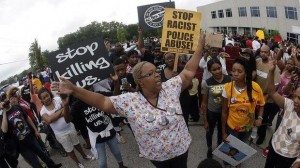by Todun Jagun

The waves of rebellion in Ferguson, Missouri, last year brought the lethal danger of racism in the United States to the fore, once again. This was after the killing of Michael Brown, an 18-year old African-American and the acquittal of Darren Wilson, the white policeman who killed him. But there have been several haunting killings of black youth and children even after Ferguson’s violent confrontation with institutionalised racism. One black person is killed every 28 hours according to Brian Becker, director of the Answer Coalition.
It is instructive to note that none of these African-Americans are rich and influential members of the 1%. They are all from poor working class backgrounds. This goes to show that there is a close relationship between class and racism. The United States was established on the pillars of this marriage. The blood of Native Americans and enslaved blacks was the foundation on which American capitalism flourished at birth. But in this marriage of oppression, racism serves capitalism.
Blacks who have been able to make their peace with the system, anointed by wealth or public office do matter to the white bosses, because they are part of them! It is poor blacks’ lives that do not matter, getting wasted by the bullets of police, harassed and rendered homeless in the projects, languishing in jails and generally treated as nothing but dregs. This is why Malcolm X spoke about the house slave who worries about the master’s health and the field slave who sees his liberation in the death of the master.
Slavery, even as wage slavery is first and foremost a class position of being exploited, for which oppression and ideological conditioning are required perpetuating the slavish submission. To strike at the chains of bondage, the exploited must challenge the master class. In the case of poor African-Americans, anti-racism and working class struggle must be two edges of sword to fight for self-emancipation.
It is a struggle for workers of all colours, ethnicity and creed. We have to be united in struggle against the capitalist system and against its use of racial, ethnic or any other identity politics to divide us. This was the vision behind the mass mobilisation of the Congress of Industrial Organisations starting in the 1930s during the Great Depression. By the 1950s, the bosses’ successful attacks against Communists in the labour movement, leveraging on the mood of the Cold War, paved the way for denuding the class content of African-Americans anti-racist struggles.
By the time the civil rights movement was born in the 1960s, most of its leaders like Martin Luther King limited its demands to just that: civil rights for blacks. But without struggle focussed on overthrowing the bosses’ capitalist system, civil rights gains got rolled back in no time. As the National Urban League stated in its State of Black America report released in March, “the actual practice of segregation, is greater now than it was 40 years ago”, with “Black and Brown students” being “less likely to share classrooms with white students”.
There are two nations in every “nation”, that of the rich, the 1% and that of the poor, the 99%. It is the 99% of blacks who face continued racism both because they are black and (more especially) poor. Black, brown and white workers in the United States have to stand together and fight racism, in a collective struggle to end capitalism.








